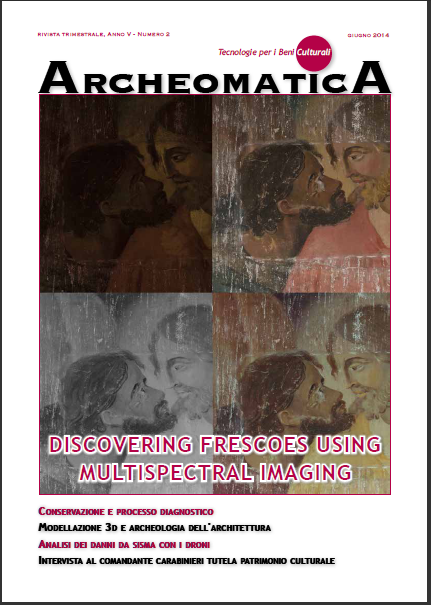The Crucifix Chapel of Aci Sant'Antonio: Newly discovered frescoes
DOI:
https://doi.org/10.48258/arc.v5i2.320Parole chiave:
multispectral imaging, frescoes, pXRF, X-ray fluorescence,Abstract
Abstract
In this paper we present the discovery of a series of frescoes for the first time, revealed in 2012 during a restoration carried out in the Crucifix chapel in the Mother Church of Sant'Antonio in the town Aci Sant'Antonio (Catania, Sicily). The murals were preserved in each of the corners of the square chapel behind the XIX° century counter wall. In this paper we also show the application of multispectral imaging (MSI) and portable XRF spectroscopy (pXRF) for the identification of pigments on this interesting case of painted murals. Documentation from the 19th century remodeling is available, and when taken into account along with this case study, represents an interesting case of "terminus ante quem” (TAQ) chronology since we are aware of the date when the last retouching to the square chapel walls could have been applied.
Abstract
Questo lavoro presenta per la prima volta la scoperta di una serie di affreschi effettuata nel 2012 durante il restauro della cappella del crocifisso nella chiesa madre di Aci Sant'Antonio, Sicilia. Le pitture murali si sono conservate in ognuno degli angoli della cappella quadrata dietro le contropareti aggiunte nel XIX secolo. In questo articolo si mostra anche l'applicazione combinata dell'imaging multispettrale (MSI) e della spettroscopia di fluorescenza X portatile (pXRF) per l'identificazione dei pigmenti su queste pitture murali da poco scoperte. Dopo una ricerca d'archivio, e' stata ritrovata la documentazione degli interventi che hanno portato alla copertura degli affreschi nel XIX secolo. Dal momento che siamo al corrente dell'anno in cui gli ultimi interventi sugli affreschi possono essere stati eseguiti, questi murali rappresentano un interessante caso di cronologia "terminus ante quem” (TAQ), in particolare per quel che riguarda l'uso dei pigmenti.
Riferimenti bibliografici
A. Cosentino "A practical guide to panoramic multispectral imaging” e-Conservation Magazine, 25, pp 64-73, 2013.
J. Warda (ed.), F. Frey, D. Heller, D. Kushel, T. Vitale, G. Weaver "AIC Guide to Digital Photography and Conservation Documentation, 2nd Edition” American Institute for Conservation of Historic and Artistic Works, 2011.
A. Paradisi, A. Sodo, D. Artioli, A. Botti, D. Cavezzali, A. Giovagnoli, C. Polidoro. M. A. Ricci "Domus Aurea, the ‘Sala delle maschere': Chemical and spectroscopic investigations on the fresco paintings” Archaeometry, volume 54, issue 6, 2012.
E. West Fitzhugh (Editor) "Artists' Pigments: A Handbook of Their History and Characteristics (Vol 3)" National Gallery of Art; 3 edition, pp 273-293, 1997.
E. René de la Rie "Fluorescence of Paint and Varnish Layers (Part III)” Studies in Conservation, Vol. 27, No. 3, pp 102-108, 1982.
D. Comelli, G. Valentini, A. Nevin, A. Farina, L. Toniolo, R. Cubeddu "A portable UV-fluorescence multispectral imaging system for the analysis of painted surfaces” Review of Scientific Instruments, 79, 2008.
G. Savage "Forgeries, fakes, and reproductions, a handbook for collectors” White Lion Publishers Ltd., London, appendix 3, 1976.
J. J. Rorimer "Ultraviolet rays and their use in the examination of works of art” Metropolitan Museum of Art; 1st Ed., 1931.
A. Aldrovandi, E. Buzzegoli, A. Keller, D. Kunzelman "Investigation of painted surfaces with a reflected UV false color technique” art'05, 8th International Conference on Non Destructive Investigations and Micronalysis for the Diagnostics and Conservation of the Cultural and Environmental Heritage Lecce (Italy), 2005.
T. Moon, M. R. Schilling, S. Thirkettle "A Note on the Use of False-Color Infrared Photography in Conservation” Studies in Conservation, Vol. 37, No. 1, pp. 42–52, 1992.
C. Hoeniger "The identification of blue pigments in early Sienese paintings by color infrared photography” Journal of American institute of Conservation, Volume 30, Number 2, Article 1, pp 115-124, 1991.
D.C. Creagh, D.A. Bradley "Radiation in Art and Archeometry” Elsevier, pp 40–55, 2000.
J. W. Mayer "The Science of Paintings” Springer-Verlag New York, Inc., pp 125–127, 2000.
J. R. J. van Asperen de Boer "Reflectography of Paintings Using an Infrared Vidicon Television System” Studies in Conservation, Vol. 14, No. 3, pp 96–118, 1969.
C. M. Falco "High-resolution infrared imaging” SPIE Optics + Photonics Conference, San Diego, 2010.
S. Ridolfi "Portable X-ray Fluorescence Spectrometry for the analyses of Cultural Heritage” IOP Conference Series: Materials Science and Engineering XTACH 11, 37, 2012.
N. Vornicu, C. Bibire, E. Murariu, and D. Ivanov "Analysis of mural paintings using in situ non-invasive XRF, FTIR spectroscopy and optical microscopy” X-ray Spectrometry, 2013.
M. K. Donais, D. George, B. Duncan, S. M. Wojtas, A. M. Daigle "Evaluation of data processing and analysis approaches by portable X-ray fluorescence spectrometry and portable Raman spectroscopy” Analytical Methods vol 3 no. 5, 1017-1014, 2011.
E. West Fitzhugh (Editor) "Artists' Pigments: A Handbook of Their History and Characteristics (Vol 3)" National Gallery of Art; 3 edition, 1997, pp 219-271.
S. Giovannoni, M. Matteini, A. Moles "Studies and Developments concerning the Problem of Altered Lead Pigments in Wall Painting” Studies in Conservation, Vol. 35, No. 1, pp. 21-25, 1990.
R. D. Harley "Artists' Pigments c. 1600-1835" Butterworth-Heinemann, 2 edition, 1982
##submission.downloads##
Pubblicato
Come citare
Fascicolo
Sezione
Licenza
Gli autori che pubblicano su questa rivista accettano le seguenti condizioni:- Gli autori mantengono i diritti sulla loro opera e cedono alla rivista il diritto di prima pubblicazione dell'opera, contemporaneamente licenziata sotto una Licenza Creative Commons - Attribuzione che permette ad altri di condividere l'opera indicando la paternità intellettuale e la prima pubblicazione su questa rivista.
- Gli autori possono aderire ad altri accordi di licenza non esclusiva per la distribuzione della versione dell'opera pubblicata (es. depositarla in un archivio istituzionale o pubblicarla in una monografia), a patto di indicare che la prima pubblicazione è avvenuta su questa rivista.
- Gli autori possono diffondere la loro opera online (es. in repository istituzionali o nel loro sito web) prima e durante il processo di submission, poiché può portare a scambi produttivi e aumentare le citazioni dell'opera pubblicata (Vedi The Effect of Open Access).





